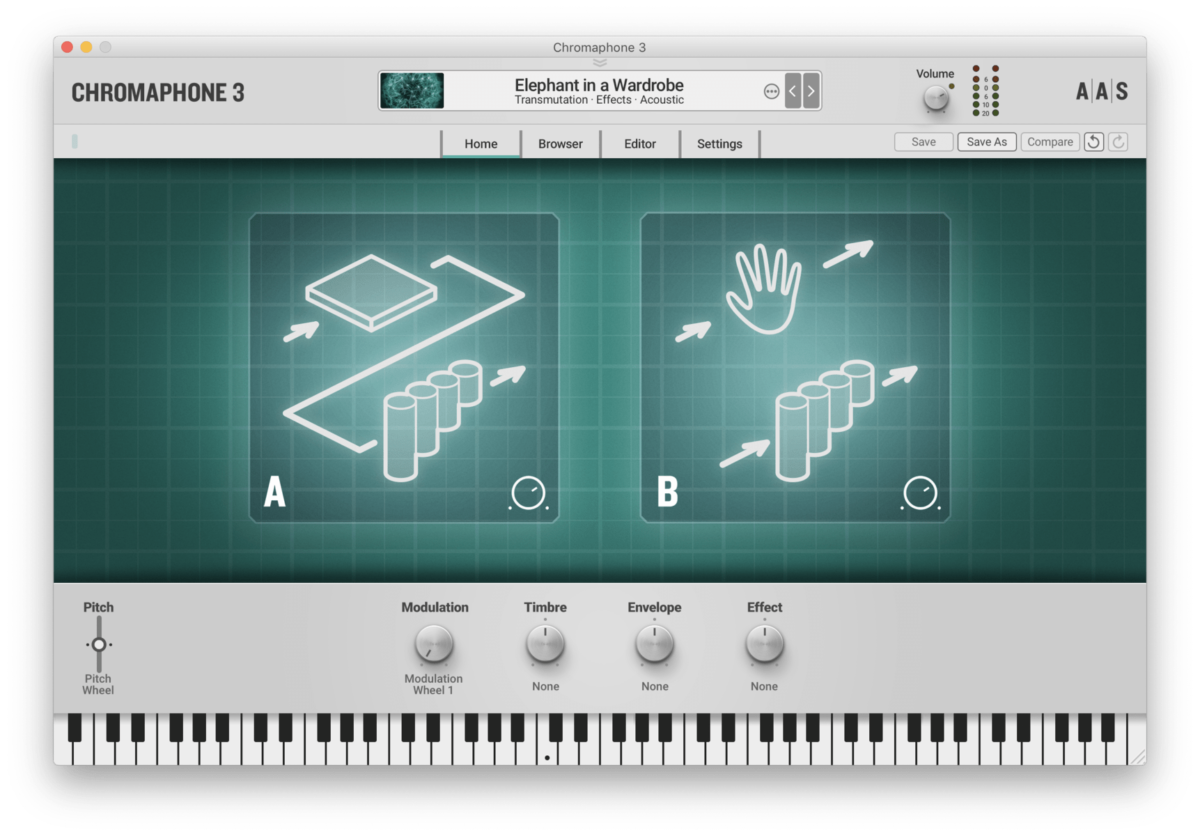In This Issue
Exclusive Synth and Software Review: Applied Acoustic Systems Chromaphone 3

Rev your engines! Contributor Marty Cutler is waiting on the start line.
Applied Acoustic Systems (AAS) delivers dramatic upgrades to their expansive line of physically modeled instruments. Their most recent is Chromaphone 3. Although it’s described as a percussion synthesizer, a random skim through the presets reveals a range from startlingly realistic snares and other percussion sounds through plaintive leads, and glassy, sparking pads.
Upgrades to the software include the instrument’s new multitimbral capabilities, with a pair of dual-oscillator synth engines for allowing simple splits and layers. There are no independent MIDI channels, but you can limit keyboard ranges, pan position, and although there is no velocity split per se, you can dynamically alter the balance between the engines with MIDI Control Change messages.
People familiar with Chromaphone 2 will recognize the engine:
It has filters, envelopes, LFOs, and other subtractive synthesis tools, but an understanding of the physics of sound propagation is important if you really want to go beyond simple tweaks.
Chromaphone’s user interface breaks down into four main pages. Home (shown above) is the performance page. You can see the instrument’s signal flow, and four Macro knobs: Modulation, Timbre, Envelope, and Effect. You can assign Channel Pressure (Aftertouch) or your choice of MIDI Control-Change messages as sources.
Now let’s click on the Editor tab.
Here’s a potent combination of acoustic modeling and subtractive synthesis. Each of the two synth engine layers comprises a pair of resonators. These can act as two discrete tone-generating components in a parallel signal flow. Or they can be coupled, in which case one resonator passes its signal to the other. But unlike in a serial arrangement, the signals generated by each resonator interact, much as vibrations from a guitar string interact with the materials in the body and neck.
You can choose from a number of materials for each resonator. So, for example, you can feed the resonance of a string into a hollow tube (and vice versa). Similarly, you could feed a drum head to a membrane, and intermingle a resonating plate with an additive synthesis resonator. Graphics change to show each resonator’s coupled or decoupled state.
The Editor subdivides into Modes, Synth, and Effects. Modes cover the broader, performance-oriented features. These include the number of voices, vibrato, arpeggiator parameters, and the Macro destinations and amounts. With up to four destinations for each macro, you can create startling changes to a patch. I had great results on percussive sounds changing resonator diameter using the mod wheel.
The Arpeggiator section is simple and straightforward. In addition to a few variations on back-and-forth arpeggiation, you can program the arpeggiator to play chords and to disperse notes within a range of up to four octaves. A Span parameter determines whether the range starts above the original note pitches, below, or alternates.
Patterns can be any length up to 16 steps, and each one can be on or off. Although all notes adhere to the same duration as set in the Steps parameter, rhythmic possibilities become more intriguing with the second layer’s independent arpeggiator in play. Polyrhythms anyone?
What makes Chromaphone unique, however, is the interaction between multiple physical models coupled with more familiar elements of subtractive and additive synthesis. Despite its categorization as a percussion synthesizer, Chromaphone’s broad palette of sounds is mind-bending. Its overarching sonic characteristic is digital, with a vengeance. Bell-like tones – even ones that are surreal rather than realistic – have a crisp, acoustic sound.
There are broad categories – tube, membrane, plate, and strings – and then you can change the material of each resonator, with a drastic effect on the timbre. You won’t find a preset selection of specific materials used or tables for figuring this out in the documentation, just a knob that changes the decay time of the layer’s partials. The manual describes the process, albeit in a more academic than practical way.
Other tone-shaping parameters include tone controls and a low-cut filter, one for each resonator when they’re uncoupled, or one for a coupled pair. In any case, a little experimentation will give you a feel for making the timbral adjustments you need.
A noise oscillator functions with more conventional filter controls. Along with a graphical filter, you get a few variants and a combination of high-, low-, and band-pass filters with cutoff and Q.
You can tie filter modulation to the single ADSR/AHD envelope, the LFO, Key Follow, or Velocity. As one would expect, you set the amount of modulation, from negative to positive values. Inverted keyboard-following pitch settings à la Joe Zawinul would be a welcome addition. A tremendous variety of alternative tunings (Chromaphone supports Scala tuning files) are available from the Settings page, so an invertible keyboard shouldn’t be too far afield.
AAS supplies a huge library of patches from a long list of sound-design luminaries, including Richard Devine, Daniel Stawczyk, Niall McCallum, Francis Preve, Jerry Kovarsky, and Simon Stockhausen. The company is aggressive with updates to their sound libraries.
Their most recent addition to Chromaphone is Michael Basque’s Transmutations, a grab bag of surreal and ethnic-inspired patches, loaded with animated bells, pads with undercurrents of subtle, fluttering attacks, and FM-like keyboards. All sounds are available from the Chromaphone Browser, which can quickly sort sounds by author, instrument categories, and much more. It’s a vast improvement over their previous drop-down menu, and possibly the best-designed browser I’ve seen.
With an enormous library of sounds, suitable for most musical occasions, a fascinating and versatile pair of synth engines, and a powerful and easily arranged rack of effects, Chromaphone is an outstanding synth to add to your studio. I recommend it highly, but don’t take my word for it: download a fully functional demo from https://www.applied-acoustics.com/chromaphone-3/.



















